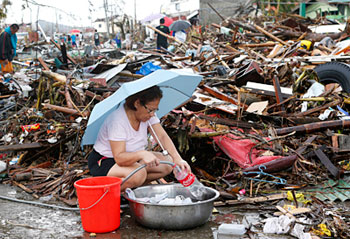

Vol. 77/No. 42 November 25, 2013

|
| Reuters/Erik De Castro |
| Town of Palo in central Philippines, Nov. 12, four days after typhoon hit. The government made no attempt to evacuate beforehand and very little aid is reaching those in dire need. |
For hundreds of thousands of working people in the Philippines — particularly those in the most vulnerable low-lying areas — no attempt was made to evacuate them. Instead they were left to fend for themselves in face of the powerful Typhoon Haiyan that ripped through the archipelago nation Nov. 8.
As of Nov. 13, government figures put the number dead at just over 2,300, but the real toll is widely assumed to be far higher, with many thousands still missing. More than 600,000 lost their homes, according to government reports and 30 percent of the country’s provinces are without electricity.
Hardest hit were lowlands near coastlines and river banks most prone to flooding. As usual, the land in these regions is low-value and densely inhabited by workers, farmers and fishermen living in houses made of wood and other light materials. In Tacloban, “poor neighborhoods fared especially badly, with virtually no structures left standing, other than government buildings,” wrote the New York Times Nov. 11. In 1991, a less powerful tropical storm killed 5,000 people in many of the same areas.
“Let us evacuate our homes if we are in danger zones,” President Benigno Aquino said in a televised address a day before the typhoon hit, but providing no means or place for hundreds of thousands to go. Many schools, gymnasiums and other buildings designated as evacuation centers in hard-hit areas were destroyed.
Evacuation centers became death traps, as people huddling in basements drowned from the storm surge.
Hundreds of thousands trapped in areas where roads are impassable or no longer exist face acute shortages of water, food and medicine, and unsanitary conditions.
“I know the incredible resiliency of the Philippine people and I am confident that the spirit of Bayanihan will see you through this tragedy,” President Barack Obama said in a Nov. 10 statement. He said the U.S. government is “already providing significant humanitarian assistance” — which, according to press reports, consists of $100,000 from the U.S. Embassy and a military cargo plane dispatched from Manila with a contingent of Marines, bottled water, generators, a forklift and two trucks.
The Defense Department announced in a Nov. 11 press release it was sending the aircraft carrier USS George Washington with “an array of aircraft designed to perform disaster relief as well as other functions,” to “support ongoing efforts led by the Philippines’ government and military.” The ships are expected to arrive Nov. 13-14. “The Defense Department is continuing to work closely with the Philippine government to determine what, if any, additional assets may be required,” the Pentagon reported.
Two days after the typhoon hit, President Aquino declared a “state of calamity,” which, according to the Times, represented “a first step in the release of emergency money.” But, the Times said, the emergency funds have already been “depleted” by other disasters, particularly the large earthquake that struck the center of the country last month. Meanwhile, hundreds of police and soldiers have been deployed to Tacloban in response to “rising fears of a breakdown of law and order after reports of widespread looting.”
Mark Fernando, a volunteer for the Philippine Red Cross, told Reuters that his relief team couldn’t get to Tacloban, because the government wouldn’t provide the space on military flights. “They said, ‘Our priority is to bring in soldiers and policemen,’” he said.
Related article:
Immediate and massive aid to Philippines!
Front page (for this issue) |
Home |
Text-version home